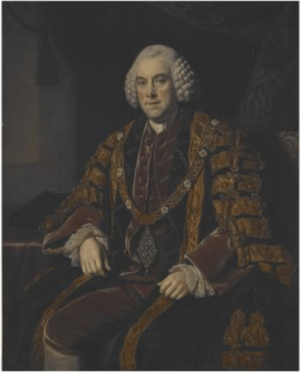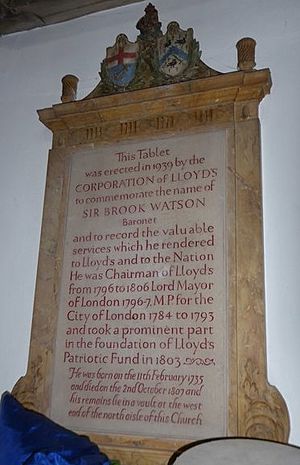Brook Watson facts for kids
Quick facts for kids
Sir Brook Watson, Bt
|
|
|---|---|

Sir Brook Watson, c.1796, Copley, John Singleton (17381815) Indianapolis Museum of Art, USA
|
|
| Born | 7 February 1735 Plymouth, Devon, England
|
| Died | 2 October 1807 (aged 72) England
|
| Occupation | Merchant |
| Spouse(s) | Helen Campbell |
Sir Brook Watson (born February 7, 1735 – died October 2, 1807) was an important British businessman and soldier. He later became the Lord Mayor of London, a very important leader in the city. Many people know him because of a famous painting called Watson and the Shark. This painting shows a scary moment from his childhood when a shark attack caused him to lose his right leg.
Contents
Early Life and a Shark Attack
Brook Watson was born in Plymouth, England, in 1735. When he was only six years old, he became an orphan. He then went to live with his aunt and uncle in Boston, Massachusetts. His uncle was a merchant, which means he bought and sold goods, often trading with places in the West Indies.
Before he turned 14, Brook was very interested in the sea. So, his uncle arranged for him to work as a crew member on one of his trading ships.
Shark Attack in Cuba
In 1749, when Brook was 14, he was swimming alone in Havana harbor, Cuba. Suddenly, a shark attacked him! The shark attacked twice before his shipmates could rescue him. First, the shark bit a large piece of flesh from his right leg. Then, it bit off his right foot at the ankle.
His shipmates saved him, but his leg had to be amputated (removed) below the knee. Brook stayed in a Cuban hospital and recovered within three months.
Military and Business Career
When Brook Watson returned to Boston, he found that his uncle had lost all his money. So, Brook took a job helping Captain John Huston. He worked on a ship that brought supplies to the British army at Fort Lawrence, Nova Scotia, in 1750.
At Fort Lawrence, a military leader named Robert Monckton noticed Brook. By 1755, Brook was working as a commissary (someone who supplies food and equipment to the army) with Monckton at the Battle of Fort Beauséjour. He continued to work with the army, helping to manage supplies. People sometimes called him 'the wooden-legged commissary' because of his prosthetic leg.
In 1759, Watson moved to London to continue his business career. He became a very successful merchant, doing business in London, Montreal, and Boston. He even helped get a large piece of land in Nova Scotia in 1763.
Working with the Government
Brook Watson was a key member of the Corporation of Lloyd's of London, a famous insurance market, and later became its chairman for ten years.
He often mixed his business dealings with government work. Before the American Revolutionary War, he visited American colonies. During this time, he sent important letters to General Thomas Gage, a British commander. Some people, like William Dunlap, believed Watson was gathering information for the British government.
In 1775, Watson traveled from Canada to England with an American prisoner named Ethan Allen. Allen later wrote that Watson was "a man of malicious and cruel disposition."
Watson also worked as a Commissary General for the British army in North America from 1782 to 1795. This meant he was in charge of getting all the supplies the army needed. His company, Brook Watson & Co, also owned ships that hunted whales in the South Seas.
Political Life
After his time in North America, Brook Watson returned to London. He was elected as an Alderman for the City of London, which is a local government position. From 1784 to 1793, he served as a Member of Parliament for the City of London, helping to make laws for the country. He was also Sheriff of London and Middlesex in 1785.
In 1796, he achieved a very high position: Lord Mayor of London. This is a very important leadership role in the city. From 1798 to 1806, he was the Commissary-General of England, continuing his work in supplying the army. He was also a director of the Bank of England, which is a very important bank.
Watson and the Shark Painting
The famous painting Watson and the Shark was created by the artist John Singleton Copley. Watson met Copley in 1774, and he asked Copley to paint the scene of his shark attack. The painting was finished in 1778 and was shown at the Royal Academy, where it caused a lot of excitement.
Brook Watson wanted the painting to be a lesson for young people. In his will, he said that the painting should go to Christ's Hospital, a school for children. He hoped it would hang in their hall "as holding out a most usefull Lesson to Youth." The school received the painting in 1819. Later, in 1963, the National Gallery of Art in Washington, D.C., bought the painting.
Personal Life

Brook Watson married Helen Campbell in 1760. Her father was a goldsmith from Edinburgh. Brook and Helen Watson did not have any children.
On December 5, 1803, Brook Watson was made a baronet, which is a special honor given by the King. His family's coat of arms (a special symbol) even showed his shark attack! It featured Neptune, the god of the sea, and a picture of Watson's severed right leg. Below it was a Latin motto, Scuto Divino, which means 'Under God's Protection'.
Brook Watson died in 1807. Because he had no children, his baronetcy passed to his grand-nephew, William.




